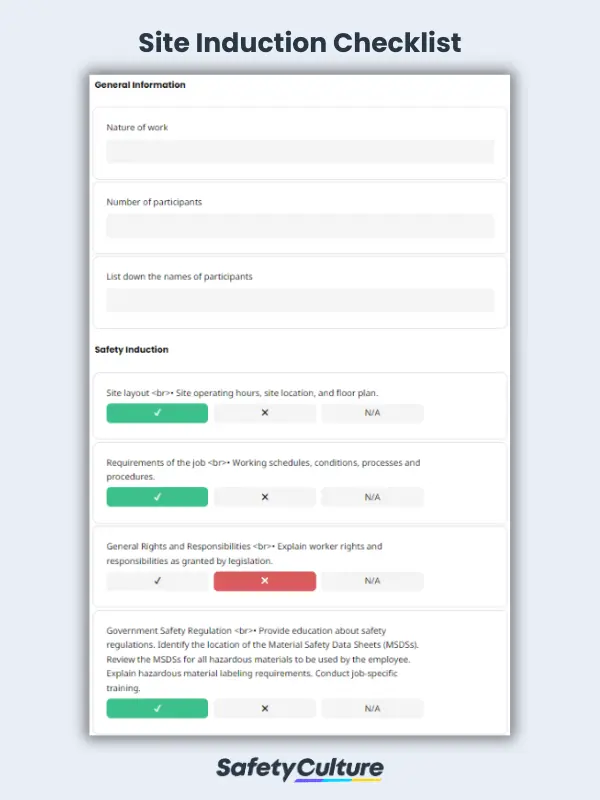What is an Induction Checklist?
An induction checklist is a tool used by HR teams when onboarding new staff or conducting site inductions for contractors. An effective induction process can help ensure all your workers achieve a base understanding of their job, safety requirements, and company culture and values.
Benefits of a Site Induction Template
An induction checklist is a well-detailed guide used to outline the training and activities for new staff or contractors. It helps ensure the following:
- all activities are covered in a timely manner;
- smooth transition of tasks; and
- prevent overlooked or duplicate training.
Tips on How to Create an Induction Checklist
Induction checklists vary depending on the complexity, size, and policies of the company. It can be customizable according to the training activities and starter needs of an employee. The following are basic tips on creating an induction checklist.
- Give an overview of the business including policies, type of work, and organizational structure.
- Introduce the key personnel and their corresponding roles.
- Familiarize new employees with the site layout including operating hours, location, site rules, and floor plan.
- Explain job requirements such as working schedules, conditions, processes, and procedures.
- Clarify worker rights and responsibilities as granted by legislation. This includes pay arrangements such as rates, allowances, overtime pay, and hazard pay.
- Orient new employees on company safety rules and policies including hazards, risks, and emergency and evacuation plans.
- Introduce and review the PPE program if the employee will be required to wear protective equipment.
- Discuss the site housekeeping SOP and proper handling of toxic products.
- Include a site tour and show the working areas and other facilities.
What is Site Induction?
Site induction (or site safety induction) is the process of introducing the organization, operation on site, and protocols in hazard-prone areas. It helps ensure and promote the safety of people who are not familiar with the site including new hires or project-based employees, visitors, and contractors. Failure to perform site induction may put people at risk of having injuries or commit unexpected property damage.
4 Major Site Induction Requirements You Should Not Overlook
Conducting proper site induction is necessary for businesses to avoid tendencies of negligence or non-adherence to health and safety regulations. The following site induction requirements can provide adequate information to employees to deal with hazards properly:
Hazards and risks associated in your workplace
It is valuable for employees to know the hazards inherent to their job before commencing work. Essential information such as workplace plans, working methods, operating hours, and standard regulations should be communicated to prevent any unnecessary incidents and accidental injuries.
Safe work practices
Site employees should be aware of the safe work practices implied in your organization to establish a healthy and safe environment. An introduction to proper equipment handling serves as an overview of what to expect at the site and how employees have to execute machinery and equipment properly. Below are general safe work practices that you can discuss:
- Understanding the functionality of safety devices;
- Wearing appropriate Personal Protective Equipment (PPE);
- Awareness of manufacturers specifications;
- Compliance with regulatory standards; and
- Work etiquette including handling, storing and disposing of materials, cleanliness, and equipment maintenance.
Emergency procedures
Emergency procedures are vital for the safety of the organization during inevitable events. It helps secure employee and business safety in case of a power interruption, calamities, accidents, or near misses. The following are general topics about emergency procedures every employee must be aware of:
- Employee awareness on emergency exits, evacuation instructions, emergency marshals, and assembly points as part of emergency evacuation and contingency plan;
- Location of first aid kits and its contents;
- Proper execution of first aid; and
- Reporting of incidents.
Attendance confirmation
Employee conformance and attendance are the most important part of site inductions. All employees should be heavily involved to understand the purpose of induction and make sure they sign-off an induction form. An induction form is used as an official register of a new employee or contractor has received an introduction on business safety systems, protocols, and procedures.
How to Effectively Perform Contractor Site Induction
Most contractors are project-based employees and oftentimes carry out much of the work on-site. Familiarity in the workplace is important to avoid employee exposure to injuries or fatalities and put your business into risk. Perform contractor site induction by following these simple steps below:
- Allot time for induction
Time is important when conducting inductions to fully understand the function and responsibilities of each employee before they commence to work. - Set employee expectations
Provide the agenda and the topics that need to be discussed so that new employees’ expectations are set on what to see and learn during the induction. - Engage with them
Ensure all items discussed were understood by the employees. Highlight the crucial information they need to learn such as hazards, safety, and emergency protocols. - Open for Q and A
Open the floor for questions and answers. Provide valuable answers to clarify their questions and encourage them to share their thoughts about the topics that have been discussed. - Document the site induction
It is important to record and document the completion of site induction. It will serve as evidence in case of incident and insurance claims.
What is Induction Training?
In any workplace, whether it’s high-risk or low-risk, there are always safety and health hazards that can be detrimental if not prevented. With an induction training program in place, you’ll be able to introduce your employees to the health and safety protocols at work. This training program will provide your workers with knowledge in recognizing and mitigating risks at work, as well as in performing their duties safely. It also helps ensure that your organization is compliant with the health and safety legal requirements set by your local government. Prioritizing health and safety at work can help in increasing productivity, which also results in smoother and more efficient operations.
To help you get started, we’ve created a list of safety induction training courses that can be used to introduce new employees to the basic health and safety practices at work. These courses were created to help new hires stay compliant and perform their duties effectively and safely.



